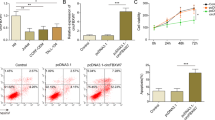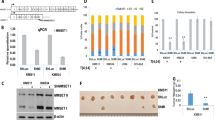Abstract
Multiple myeloma (MM) is a plasma cell neoplasm which is characterized by widespread genetic heterogeneity. The MMs with t(4;14) translocation exhibit poor outcomes. However, the mechanism underlying has not been well dissected. Our study aimed to identify key microRNA involved in the oncogenesis of t(4;14) MM. We here performed an integrated analysis to screen important regulators in the pathogenesis of t(4;14) MM. We used real-time quantitative polymerase chain reaction and western blotting to evaluate the mRNA and protein expression of the indicated microRNA or protein. Cell proliferation assay, colony formation assay, and transwell assay were used to examine the cell growth and metastasis. More importantly, the tumor growth and metastasis were analyzed in nude mice injected with MM cells. The integrated analysis indicated that miR-532 functioned as a pivotal regulator in t(4;14) MM. miR-532 was upregulated in t(4;14) MMs and promotes cell growth and metastasis in vitro and in vivo. Notably, though combing bioinformatics analysis and functional assays, CAMK2N1 was revealed as a functional target of miR-532 in MM cells. CAMK2N1 plays an anti-proliferative and anti-migration role in MM cells, and miR-532 exerts its oncogenic role though inhibiting CAMK2N1 expression in MMs. miR-532 promotes cell proliferation and invasion in t(4;14) MMs by targeting CAMK2N1. Our study, thus, provides possible targets for t(4;14) MM therapy.







Similar content being viewed by others
References
Greipp PR, San Miguel J, Durie BG, Crowley JJ, Barlogie B, Blade J, et al. International staging system for multiple myeloma. J Clin Oncol. 2005;23(15):3412–20. https://doi.org/10.1200/jco.2005.04.242.
Kyle RA, Remstein ED, Therneau TM, Dispenzieri A, Kurtin PJ, Hodnefield JM, et al. Clinical course and prognosis of smoldering (asymptomatic) multiple myeloma. N Engl J Med. 2007;356(25):2582–90. https://doi.org/10.1056/nejmoa070389.
Palumbo A, Anderson K. Multiple myeloma. N Engl J Med. 2011;364(11):1046–60. https://doi.org/10.1056/nejmra1011442.
Cid Ruzafa J, Merinopoulou E, Baggaley RF, Leighton P, Werther W, Felici D, et al. Patient population with multiple myeloma and transitions across different lines of therapy in the USA: an epidemiologic model. Pharmacoepidemiol Drug Saf. 2016;25(8):871–9. https://doi.org/10.1002/pds.3927.
Lokhorst HM, Plesner T, Laubach JP, Nahi H, Gimsing P, Hansson M, et al. Targeting CD38 with daratumumab monotherapy in multiple myeloma. N Engl J Med. 2015;373(13):1207–19. https://doi.org/10.1056/nejmoa1506348.
Lonial S, Dimopoulos M, Palumbo A, White D, Grosicki S, Spicka I, et al. Elotuzumab therapy for relapsed or refractory multiple myeloma. N Engl J Med. 2015;373(7):621–31. https://doi.org/10.1056/nejmoa1505654.
Miguel JS, Weisel K, Moreau P, Lacy M, Song K, Delforge M, et al. Pomalidomide plus low-dose dexamethasone versus high-dose dexamethasone alone for patients with relapsed and refractory multiple myeloma (MM-003): a randomised, open-label, phase 3 trial. Lancet Oncol. 2013;14(11):1055–66. https://doi.org/10.1016/s1470-2045(13)70380-2.
Stewart AK, Rajkumar SV, Dimopoulos MA, Masszi T, Spicka I, Oriol A, et al. Carfilzomib, lenalidomide, and dexamethasone for relapsed multiple myeloma. N Engl J Med. 2015;372(2):142–52. https://doi.org/10.1056/nejmoa1411321.
Hideshima T, Mitsiades C, Tonon G, Richardson PG, Anderson KC. Understanding multiple myeloma pathogenesis in the bone marrow to identify new therapeutic targets. Nat Rev Cancer. 2007;7(8):585–98. https://doi.org/10.1038/nrc2189.
Boyd KD, Ross FM, Chiecchio L, Dagrada GP, Konn ZJ, Tapper WJ, et al. A novel prognostic model in myeloma based on co-segregating adverse FISH lesions and the ISS: analysis of patients treated in the MRC Myeloma IX trial. Leukemia. 2012;26(2):349–55. https://doi.org/10.1038/leu.2011.204.
Morgan GJ, Walker BA, Davies FE. The genetic architecture of multiple myeloma. Nat Rev Cancer. 2012;12(5):335–48. https://doi.org/10.1038/nrc3257.
Eis PS, Tam W, Sun L, Chadburn A, Li Z, Gomez MF, et al. Accumulation of miR-155 and BIC RNA in human B cell lymphomas. Proc Natl Acad Sci USA. 2005;102(10):3627–32. https://doi.org/10.1073/pnas.0500613102.
Calin GA, Ferracin M, Cimmino A, Di Leva G, Shimizu M, Wojcik SE, et al. A MicroRNA signature associated with prognosis and progression in chronic lymphocytic leukemia. N Engl J Med. 2005;353(17):1793–801. https://doi.org/10.1056/nejmoa050995.
Yu SL, Chen HY, Chang GC, Chen CY, Chen HW, Singh S, et al. MicroRNA signature predicts survival and relapse in lung cancer. Cancer Cell. 2008;13(1):48–57. https://doi.org/10.1016/j.ccr.2007.12.008.
Wu YC, Lee KS, Song Y, Gehrke S, Lu B. The bantam microRNA acts through Numb to exert cell growth control and feedback regulation of Notch in tumor-forming stem cells in the Drosophila brain. PLoS Genet. 2017;13(5):e1006785. https://doi.org/10.1371/journal.pgen.1006785.
Yang M, Zhang L, Wang X, Zhou Y, Wu S. Down-regulation of miR-203a by lncRNA PVT1 in multiple myeloma promotes cell proliferation. Arch Med Sci. 2018;14(6):1333–9. https://doi.org/10.5114/aoms.2018.73975.
Croce CM. Causes and consequences of microRNA dysregulation in cancer. Nat Rev Genet. 2009;10(10):704–14. https://doi.org/10.1038/nrg2634.
Lionetti M, Biasiolo M, Agnelli L, Todoerti K, Mosca L, Fabris S, et al. Identification of microRNA expression patterns and definition of a microRNA/mRNA regulatory network in distinct molecular groups of multiple myeloma. Blood. 2009;114(25):e20–6. https://doi.org/10.1182/blood-2009-08-237495.
Zhou Y, Chen L, Barlogie B, Stephens O, Wu X, Williams DR, et al. High-risk myeloma is associated with global elevation of miRNAs and overexpression of EIF2C2/AGO2. Proc Natl Acad Sci USA. 2010;107(17):7904–9. https://doi.org/10.1073/pnas.0908441107.
Gutierrez NC, Sarasquete ME, Misiewicz-Krzeminska I, Delgado M, De Las Rivas J, Ticona FV, et al. Deregulation of microRNA expression in the different genetic subtypes of multiple myeloma and correlation with gene expression profiling. Leukemia. 2010;24(3):629–37. https://doi.org/10.1038/leu.2009.274.
Agnelli L, Fabris S, Bicciato S, Basso D, Baldini L, Morabito F, et al. Upregulation of translational machinery and distinct genetic subgroups characterise hyperdiploidy in multiple myeloma. Br J Haematol. 2007;136(4):565–73. https://doi.org/10.1111/j.1365-2141.2006.06467.x.
Agnelli L, Bicciato S, Mattioli M, Fabris S, Intini D, Verdelli D, et al. Molecular classification of multiple myeloma: a distinct transcriptional profile characterizes patients expressing CCND1 and negative for 14q32 translocations. J Clin Oncol. 2005;23(29):7296–306. https://doi.org/10.1200/jco.2005.01.3870.
Lewis BP, Burge CB, Bartel DP. Conserved seed pairing, often flanked by adenosines, indicates that thousands of human genes are microRNA targets. Cell. 2005;120(1):15–20. https://doi.org/10.1016/j.cell.2004.12.035.
Nooka AK, Kastritis E, Dimopoulos MA, Lonial S. Treatment options for relapsed and refractory multiple myeloma. Blood. 2015;125(20):3085–99. https://doi.org/10.1182/blood-2014-11-568923.
Dimopoulos MA, Richardson PG, Moreau P, Anderson KC. Current treatment landscape for relapsed and/or refractory multiple myeloma. Nat Rev Clin Oncol. 2015;12(1):42–54. https://doi.org/10.1038/nrclinonc.2014.200.
Calin GA, Croce CM. MicroRNA signatures in human cancers. Nat Rev Cancer. 2006;6(11):857–66. https://doi.org/10.1038/nrc1997.
He H, Wang L, Zhou W, Zhang Z, Wang L, Xu S, et al. MicroRNA expression profiling in clear cell renal cell carcinoma: identification and functional validation of key miRNAs. PLoS One. 2015;10(5):e0125672. https://doi.org/10.1371/journal.pone.0125672.
Song X, Wang Z, Jin Y, Wang Y, Duan W. Loss of miR-532-5p in vitro promotes cell proliferation and metastasis by influencing CXCL2 expression in HCC. Am J Transl Res. 2015;7(11):2254–61.
Griesing S, Kajino T, Tai MC, Liu Z, Nakatochi M, Shimada Y, et al. Thyroid transcription factor-1-regulated microRNA-532-5p targets KRAS and MKL2 oncogenes and induces apoptosis in lung adenocarcinoma cells. Cancer Sci. 2017;108(7):1394–404. https://doi.org/10.1111/cas.13271.
Bai L, Wang H, Wang AH, Zhang LY, Bai J. MicroRNA-532 and microRNA-3064 inhibit cell proliferation and invasion by acting as direct regulators of human telomerase reverse transcriptase in ovarian cancer. PLoS One. 2017;12(3):e0173912. https://doi.org/10.1371/journal.pone.0173912.
Xu X, Zhang Y, Liu Z, Zhang X, Jia J. miRNA-532-5p functions as an oncogenic microRNA in human gastric cancer by directly targeting RUNX3. J Cell Mol Med. 2016;20(1):95–103. https://doi.org/10.1111/jcmm.12706.
Kitago M, Martinez SR, Nakamura T, Sim MS, Hoon DS. Regulation of RUNX3 tumor suppressor gene expression in cutaneous melanoma. Clin Cancer Res. 2009;15(9):2988–94. https://doi.org/10.1158/1078-0432.ccr-08-3172.
Wang T, Guo S, Liu Z, Wu L, Li M, Yang J, et al. CAMK2N1 inhibits prostate cancer progression through androgen receptor-dependent signaling. Oncotarget. 2014;5(21):10293–306. https://doi.org/10.18632/oncotarget.2511.
Li W, Li G, Fan Z, Liu T. Tumor-suppressive microRNA-452 inhibits migration and invasion of breast cancer cells by directly targeting RAB11A. Oncol Lett. 2017;14(2):2559–65. https://doi.org/10.3892/ol.2017.6426.
Acknowledgements
This work was supported by Natural Science Foundation of Ningbo Municipality (Grant No. 2017A610210).
Author information
Authors and Affiliations
Corresponding author
Ethics declarations
Conflict of interest
The authors declare that they have no conflict of interest.
Ethical approval
All animal experiments were conducted in accordance with the guidelines of the Ningbo First Hospital Animal Care and Use Committee. All procedures performed in studies involving human participants were approved by the ethics committee of the Ningbo First Hospital.
Informed consent
Written informed consent was obtained from each participant.
Additional information
Publisher's Note
Springer Nature remains neutral with regard to jurisdictional claims in published maps and institutional affiliations.
Rights and permissions
About this article
Cite this article
Xu, K., Hu, X., Sun, L. et al. MicroRNA-532 exerts oncogenic functions in t(4;14) multiple myeloma by targeting CAMK2N1. Human Cell 32, 529–539 (2019). https://doi.org/10.1007/s13577-019-00276-y
Received:
Accepted:
Published:
Issue Date:
DOI: https://doi.org/10.1007/s13577-019-00276-y




